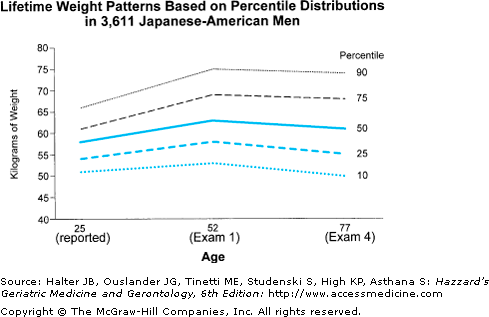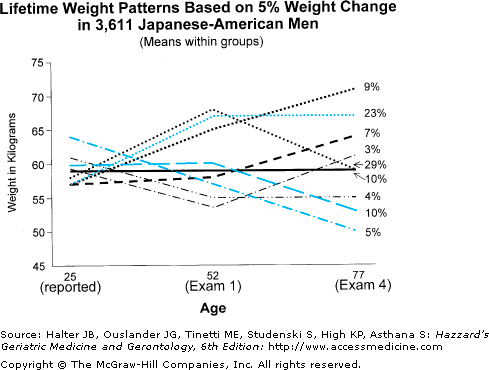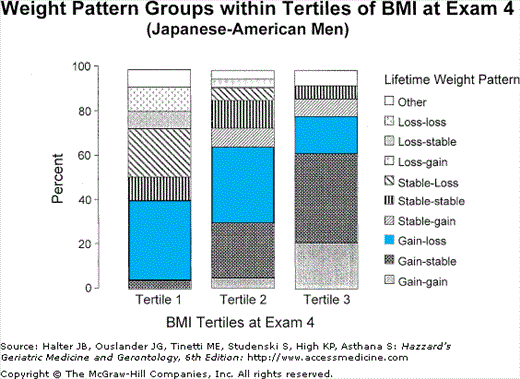Weight and Age: Paradoxes and Conundrums: Introduction
The evaluation of weight in an older person is pathognomonic of the challenges of geriatric medicine, requiring integration of information on normative biologic change with age and past individual health behaviors to assess future risk. Although weight is one of the easiest clinical measures to obtain, the interpretation of weight in the geriatric patient and assessment of the need for intervention on weight is far more difficult. This chapter provides a rationale and recommendations for an approach to weight in older patients.
Should the Health Practitioner Be Concerned About Weight in an Older Patient?
Body weight is an important contributor to health in old age. However, health practitioners are often skeptical about evaluating weight in older patients because it seems unlikely that this evaluation will change clinical treatment, except in the event of clear-cut weight loss. In practice, many of the health issues of old age are linked to weight. Clinically, weight stability is used as a sign of general health status. Weight is a contributor to the most problematic syndromes in geriatric medicine, particularly comorbidity contributing to hospitalization and physical and cognitive decline, and resulting health care costs. With the development of new drugs for symptomatic relief of weight-related conditions such as osteoarthritis and with extension to older persons of established preventive treatments for hypertension and hyperlipidemia, polypharmacy is increasingly a weight-related health issue as well. Caring for older patients involves dealing with weight-related issues on a daily basis, even if not explicitly recognized as such.
Apart from weight-related diseases, change in body composition with age, particularly the loss of muscle and bone and the increase in fat, may independently contribute to decline in functional status and loss of independence. Osteoporosis, a disease of loss of bone structure and quality, is an important risk factor for fracture. The loss of muscle with age, termed sarcopenia, is hypothesized to contribute to disability. The increase in fat mass with age may contribute as well. Adipose tissue is now known to produce multiple endocrine factors, including proinflammatory cytokines such as interleukin-6 (IL-6). IL-6 is associated with body fat, independent of weight-associated health conditions, and is also an independent risk factor for physical disability and death. Thus even accounting for body weight, change in body composition with age may independently contribute to risk.
Caloric restriction consistently promotes longevity in laboratory animals, even when restriction is instituted in adult life. Restricted animals are thinner and weigh less, reflecting their lower calorie intake, but lower weight alone does not completely explain the protection from disease and the survival advantage. Nonetheless, lower body weight appears to mediate fundamental physiological processes associated with health and longevity.
Predicting Weight in Older People: Nothing Special
Prediction of body weight from metabolic measures is similar in older and younger persons. Total energy expended daily reflects resting metabolic rate, the energy used for digestion (thermic effect of food), and physical activity. Doubly labeled water studies for total energy expenditure (a gold standard technique that uses CO2 production to calculate activity over a specified period of time) suggest that, in the absence of acute illness, the same general principles of metabolism pertain. Total energy expenditure does, however, generally decline with age. Although lean mass is known to decrease with age, the change in energy expenditure mainly reflects lower levels of discretionary activity. Total energy expenditure for persons aged 60 to 69 years averages 2186±42 kcal/day for women and 2715±56 kcal/day for men, while for persons in their seventies, the total energy expenditure was 1885±286 kcal/day for white women; 2324±436 kcal/day for black men and 2521±396 kcal/day for white men. Decreased exercise activity coupled with a small average increase in caloric intake leads to the deposition of extra body weight over time (as little as a 1% excess caloric intake over expenditure daily for a year would result in an increase of approximately 2.5 pounds in that year). Controlled feeding studies in older and younger men suggest that appetite in older people may be relatively insensitive to imbalance between calories and energy output.
Recommendations for body weight do not vary by age or race. These recommendations are based primarily on the relationship between weight and mortality, but they also account for morbidity and some disability. Body mass index (BMI), weight in kilograms divided by height in meters squared (to increase the association of this measure with percent fat), is recommended as a measurement to follow for assessment of risk associated with weight. Normal weight is considered to be a BMI between 18.5 and 25; overweight, a BMI of 25 to 30; and obesity is defined as a BMI of 30 or more. Consideration of body fat distribution has also been advocated, primarily through measurement of waist circumference as an index of central adiposity. Although there are many studies supporting the addition of waist circumference as a measure of adiposity, there are currently no agreed on cutpoints that are clearly associated with clinical outcomes. As a result, the role of waist circumference in clinical practice is still unclear. Waist circumference may be clinically useful in identifying high-risk patients for evaluation of cardiometabolic factors or to follow as a response to weight loss.
The American Society for Nutrition and the Obesity Society convened a technical review panel to review the evidence regarding the health consequences of overweight and obesity in older persons. Review of published studies from 1966 to April 2005 led this group to the conclusion that overweight, obesity, and weight-related health conditions contribute to disability. The evidence was sufficiently strong that programs to address safe and effective weight loss in older persons were considered important. Obesity and overweight are particularly important as they contribute to age-related declines in physical activity and losses in strength and muscle mass. Thus the major motivation for addressing issues of weight in old age relate to disability and the loss of independence.
Lifetime Weight History: Current Weight and Recent Weight Change Are Not Enough
Only a small proportion of people, probably less than 10% of the population, remain approximately at the same weight over their lifetime. Most people gain weight slowly over their lifetime. In Japanese American men participating in the Honolulu Heart Program, a lean and long-lived cohort, the average pattern of weight change with age was a steady increase from young adulthood to a plateau in late middle age with a decline in old age (Figure 39-1). However, the average disguises the heterogeneity in this pattern, as subgroups continue to gain and lose weight over the entire lifetime (Figure 39-2). This late life decline may be as long as 13 to 15 years, associated with many chronic conditions that increase risk of death in old age, including Alzheimer’s disease. Longitudinal studies of weight from middle age to old age show that thinner older people were often heavier earlier in life. Conversely, among heavier older people, many have gained weight since middle age (Figure 39-3). Excessive weight gain early in life was associated with premature mortality. However, as treatment for weight-associated diseases improves, it is likely that more people who have had lifelong overweight or obesity will survive into old age, joining those persons who have more recently become overweight or obese.
Figure 39-2.
Weight patterns across the lifetime from age 25 yrs to old age based on 3611 Japanese American men in the Honolulu Heart Study cohort. Each line represents one of nine weight patterns over the lifetime, with the percentages on the right side of the figure indicating the frequency of each pattern. These patterns were determined by using weight at examination 1 as the base; the position of the line for age 25 yrs and examination 4 was based on whether weight at that time was less than, greater than, or within 5% of weight at examination 1. Ten percent of the men (solid line) were within 5% of their mean weight at examination 1 on reported weight at age 25 yrs and at examination 4. Twenty-nine percent had gained 5% or more from age 25 yrs and then lost at least that much, whereas 23% had gained 5% or more from age 25 yrs and maintained that weight.
Figure 39-3.
The weight patterns across the lifetime from Figure 39-2 are shown within each tertile of the population based on increasing body mass index as measured in old age at examination 4. The legend refers to the type of change between reported weight at age 25 yrs and measured weight at examination 1 and change between measured weight at examinations 1 and 4. Men in the lowest third of body mass index in old age had lost weight (the most common patterns are gain-loss and stable-loss), whereas men in the highest third of body mass index had generally gained weight over time (the most common patterns are gain-gain and gain-stable).
As a result of the heterogeneity of such changes over a lifetime, the clinician should not assume the current weight is representative of a general lifelong pattern. Risk of disease, disability, and mortality in old age has been associated with change in weight from early adult weight (age 25 years) or from midlife, and with the difference between maximum and minimum weight. These two weight measures plus current weight and weight change over the prior 6 months constitute a reasonable weight history.
Weight loss is associated with a diverse set of factors including depression, cancer, pulmonary disease, and inflammatory arthritides. Weight loss may also be associated with diseases thought of as associated with overweight, including diabetes, coronary heart disease, and stroke, all of which may have a wasting phase. Stressful life events, such as care giving or deaths of significant others, may also play a role in either weight gain or loss. Periods of weight loss are important also as accelerators of loss in lean mass. The issue of weight loss in older people is reviewed in greater depth in Chapters 38 and 40.
Adiposity
Even if weight is maintained constant over life, the body becomes relatively fatter with age, with increases in total fat and losses in lean mass and bone. Fat redistributes centrally with the growth of the visceral fat compartment reflected as an increase in waist circumference. In many tissues, including muscle and bone marrow, there is a gradual replacement of tissue by fat. At any weight then, older people will have relatively more fat, less muscle, and less bone than will younger people.
Gain in weight and increases in body fat are associated with metabolic and physiological alterations that affect health and level of physical function. Cardiovascular risk factors of blood pressure, lipids, and glucose reflect increased weight and fat. Higher levels of intraabdominal fat are associated with insulin resistance, which may cause metabolic abnormalities even in the absence of overt overweight. Intramuscular fat may also contribute to these metabolic abnormalities. Adipose tissue has the potential for paracrine effects by release of molecular factors that influence the metabolism of muscle cells.
Adipose tissue may also play an important role in the promotion of inflammation and its health-related effects. In the past, fat was regarded primarily as an energy storage tissue primarily active in production of sex steroids and glucocorticoid metabolism. However, adipocytes actively produce and secrete a number of hormones and proteins, termed adipokines, which may have both local and systemic effects. These factors include leptin, angiotensin, resistin, adiponectin, plasminogen-activator inhibitor 1, and the cytokines, IL-6, and tumor necrosis factor alpha. Many of these substances have been associated with cardiovascular morbidity, disability, or risk of mortality. As the importance of these and other newly identified molecular metabolic regulators is identified for obesity, we may come to understand more about physiological function in old age. For instance, leptin is highly correlated with body fat even in old age, and was thought to primarily regulate fat mass. Leptin may also play a role in the regulation of bone metabolism and in the vascular system. Activated macrophages are present in adipose tissue and related to expansion of adipose depots. Subcutaneous adipose tissue may be less able to store excess lipid in obesity and in old age. As a result, ectopic growth of fat cells may occur in and around selected organs including muscle, liver, and heart.












